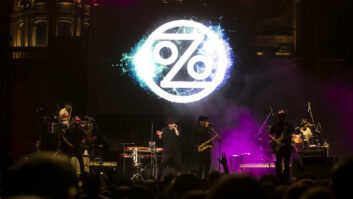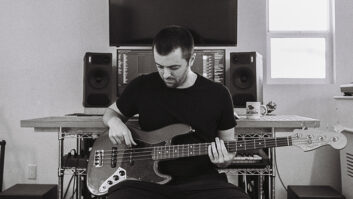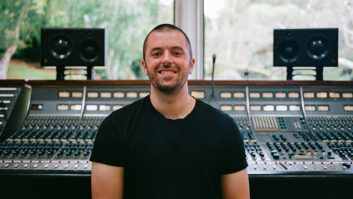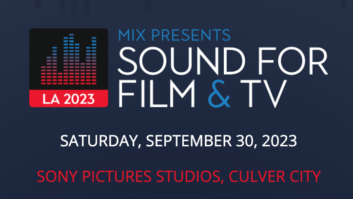Photo: Muffy Kibbey at OTR Studios
Keyboards have always provided an endless array of colors and nuance
for music projects, adding tone to an underbed or singing solo in an
extended bridge. Listen back to Charles Earland and Jimmy Smith funking
up jazz on the B3, or the Moody Blues’ Mike Pinder’s dense,
orchestrated Mellotron atmospherics, or NRBQ’s wildman Terry Smith
bashing a clavinet into one of the coolest rock ‘n’ roll instruments,
or E Power Biggs’ grand pipe organ performances of Bach, or the
amazingly subtle and musical application of analog synth on The
Beatles’ masterpiece Abbey Road.
So, in this applications feature, the focus is on keyboards. In this
feature, Tony Visconti, Cookie Marenco, Leanne Ungar and Christopher
Greenleaf describe their advice and experiences recording everything
from pipe organ and Fender Rhodes to synths and Mellotron. Mix
would also like to thank Anne Catalino and Matt Rollings for their
input.
TONY VISCONTI
Over the past three decades, Tony Visconti has produced, engineered,
mixed and arranged orchestral parts for some of the most innovative
artists in pop and rock music, including David Bowie, T-Rex, the Moody
Blues, The Move, Iggy Pop, Wings, Sparks, Strawbs, Badfinger, Gentle
Giant, The Radiators, Boomtown Rats and many others. Most recently,
Visconti was wrapping up production on Arista band Rustic
Overtones.
One of the most exotic keyboards to record is the Mellotron, and its
first cousin the Chamberlain. They are not dissimilar in concept-they
are both keyboard samplers that play prerecorded analog tapes.
[Chamberlain left the Mellotron organization to start up his own
eponymously named keyboard company.]
I started recording Mellotrons as early as 1968, after hearing that
haunting flute intro to “Strawberry Fields Forever.” In London, in
1968, you could actually hire that very same Mellotron The Beatles
hired to play that very same flute sound and also that flamenco guitar
run used at the beginning of “Bungalow Bill” [by pressing one key]. One
could also request the sound effects library rack of tapes that The
Beatles also used for the jet airliner wheels squealing at touchdown at
the beginning of “Back in the USSR.” Even before hot string sounds were
available on early ARP synthesizers, the Mellotron afforded the average
Brit pop band a sleazy opportunity to have a string section on their
record, and it wasn’t synthesized; it was the real deal, real
strings.
It isn’t so strange to learn that the Mellotron was intended to be a
home keyboard, an alternate to an electric organ. The infernal
mechanism that played a 7-second piece of tape at the touch of a key
was not meant for heavy studio or road use. I have witnessed many times
a Mellotron tape rack spewing its contents all over the control room
floor. It was a gifted roadie who knew how to wind the tapes back onto
their rack.
There are special ways to record a Mellotron. The Moody Blues were
one of the first groups to get a reasonable quality sound from this
instrument. Justin Hayward confirmed to me that Mike Pinder used to
smooth out the erratic wobble of the tapes and the limited 7-second
playback by recording the same parts triple-tracked and playing
slightly ahead and behind the beat so that the wobbles would smooth out
a little by subsequent overdubs. In my early use of the Mellotron I did
this too, with session players like Rick Wakeman and others.
The only way to record a Mellotron was from its direct output, to
get cleaner access to those tapes. It had built-in speakers, but they
made the sound even more intolerably low-fi. The tapes were divided
into three discrete tracks, so you had a violin, a cello and a flute
available on one tape rack. It was soon discovered that you could have
a violin and flute sound simultaneously by jamming the tape playback
head between settings. This is a physical procedure, not electronic
switching. One can only assume that tape head azimuth was never a
strong point of Mellotrons.
In recent years, the Mellotron has had a renaissance, and many of
these old beasts have been resurrected from scrap heaps. In the late
’60s it was apparent that the tapes were not getting any younger or
fresher with constant use. I’ve heard that nowadays there are
enthusiastic Mellotron users who’ve found the original master tapes and
are making copies for current use. This may be all well and good, but
then there are the tape heads themselves, which are rutted almost
beyond use on some units. In the ’80s I realized that there will come a
point when the last Mellotron or Chamberlain will fall sideways into
the dust, so I decided to record and sample as many Mellotrons as I
came across.
I first did this when recording with the Moody Blues in recent
years. I produced the albums The Other Side of Life [featuring
the single “Your Wildest Dreams”], Sur La Mer [featuring the
single “I Know You’re Out There Somewhere”] and Keys of the
Kingdom (seven tracks). The Moodies were reluctant to use their old
Mellotron, kept in storage for over a decade, because of its inherent
unreliability. I coaxed their road manager to dust it off and fire it
up, and I found the most exquisite string sample. Justin told me that
they commissioned the string sounds themselves because they didn’t like
the original batch that came with a Mellotron. I had my assistant
engineer run a DAT as I played and identified each note of the
chromatic scale. I then sampled only the best notes based on clarity
and the least amount of “wow” and “flutter.” Then I spanned them along
the keyboard as Akai S1000 samples-a good, clear G# would also have to
substitute for a wobbly G and A. The results sounded better than any
Mellotron on the planet.
We used the results on tracks of Keys of the Kingdom, and of course
I retained the samples for my personal sample library. The Moodies are
using my sampled string patch on their live dates to this day. What is
even more special about my samples is that I looped the notes very
carefully so that I am not limited to the 7-second length
restriction.
I was also fortunate to have a friend in Los Angeles who has an
excellent Mellotron in his possession-Jan Paulshus, a salesman for
Roland. He kindly allowed me to stick his instrument’s output into my
portable DAT recorder, and I played every note of every tape he
possessed. Let’s face it, these Mellotron tapes will never improve with
age. They can’t loop either. My philosophy is this: A good Mellotron is
a sampled Mellotron. As for the wobble of the tapes, wow and flutter, I
intend to start resampling from my DAT originals and run these samples
through my Pro Tools rig to even out some of the more vicious wobbles
with my Antares Autotune plug-in.
Here is my Mellotron credo:
A good Mellotron is a sampled Mellotron.
A good Mellotron sample is looped.
A good Mellotron loop is Autotuned.
An obvious bonus to having a looped, optimum keyboard scaled
Mellotron patch is that it is MIDI-addressable—you can
pitch-bend, play dynamically, use a sustain pedal and add chorus
effects, etc. These enviable features are lacking in the standard,
vintage Mellotron. The original, first-generation Mellotron players
clamored for these features.
As for keyboards, an electronic keyboard is a musical instrument,
not just a playback machine. An engineer thinks nothing of reaching for
outboard equipment, compressors, equalizers, effects boxes, etc., when
recording guitars, drums or vocals. With modern synths, sound designers
give you their versions of onboard effects added to their patches, and,
in most cases, they are not what you would want. I try to take the
effects off by accessing them in the synth’s menu and then process the
dry patch according to what the song demands. For lead sounds, a fat
tube compressor really toughens it up. The best way is to actually play
the synth through a hot guitar amp, mike it and maybe blend it with the
direct signal. A brass patch can benefit from being made punchier by
putting a gate across the output and a compressor after the gate.
I’m currently finishing an album for a group called Rustic
Overtones, on Arista Records. Their keyboard player, Spencer Albee,
uses vintage keyboards almost exclusively-a beat-up Hammond B-3, a
Clavinet and a Wurlitzer electric piano. For a crunchier sound on the
Clav and Wurlie, we put them through a SansAmp, the Swiss Army knife of
guitar amp simulators. Sometimes the Clav actually sounded like a
shredder guitar. Of course, there is nothing like a dedicated guitar
pedal to help spice up a keyboard, which is something we did on many
tracks.
Hammond Leslie cabinets offer lots of miking fun. Here, two AKG C-414s capture the swirling upper horn, while the bass rotor is miked in mono.
COOKIE MARENCO
Cookie Marenco is an independent engineer and producer working
mostly in the San Francisco Bay Area. She has worked with Max Roach,
Charlie Haden, Mary Chapin Carpenter, Praxis (with Brain and
Buckethead), Ladysmith Black Mambazo and Tony Furtado. Matt Rollings,
Phil Aaberg, Liz Story, Rodney Franklin, Billy Childs, Carla Bley, Dirk
Powell and Kevin Kern are among the keyboardists she has
recorded.
I used to be a keyboard player in a past life and still have about a
dozen instruments around. There’s been a renaissance in the last few
years of the older, classic instruments like the Fender Rhodes and
Hammond B-3 organ. I still haven’t found a synthesizer that can
duplicate their sound, let alone the feel and touch. Many synths can
come close, or at least close enough to save your back when schlepping
it around is an issue. In fact, my Rhodes was packed up and hidden in
storage for ten years until Myron Dove [bassist, Santana, Robben Ford]
came in one day, found all the pieces and put it together. I was
shocked at how good it sounded.
There are two things that make my job of recording easier on
keyboard. One is a great player who understands the nuances of these
instruments, like the B-3, and the second is having an instrument in
good shape. No easy feat. The B-3 can have problems like the percussion
switch not working or the Leslie spinning at an odd speed-or not at
all-and without a person who really uses those elements of the B-3,
you’d never know there was a problem. But even a busted B-3 sounds
better than any synth, as long as it makes a sound.
For miking a B-3, I like to use three tracks whenever possible. A
stereo pair on the spinning horns of the Leslie and one mic on the
bottom. I’ve used three Neumann 87s a lot of times, or two AKG C-12s as
the pair and a Sennheiser 421 on the bottom. For Matt Rollings [on
Jenna Mammina’s record] I used two 414s and an RE20. I placed the mics
about six to eight inches from the horns on opposite sides to make the
most of the Leslie spin. Matt is a master with the Leslie toggle switch
and the volume pedal, which certainly makes my job easier.
The B-3 can be tricky if the headphones aren’t just right, because
the player will make adjustments with the volume pedal, like it or not.
It’s one of the more difficult instruments to get just right in the
‘phones. It will affect level to tape, how the other players are
hearing and change the sound of the miking. It can ruin a whole session
when it’s not right. Even more difficult is when the B-3 player is
using the bass pedals and functioning as the bass player. It takes real
mastery of the instrument to not make a murky mess of the performance.
Compression to the ‘phones can help.
On rare occasions, I’ve been talked into doing a B-3 overdub,
and this headphone issue had plagued me so much that I’ve taken to
setting a pair of Genelecs up on the instrument and not using ‘phones.
Fortunately, with the Leslie, you can set it up to avoid bleed, but a
lot of times, I’ll record regardless of the bleed. No ‘phones just
makes for a better performance if your recording allows it.
A special aspect that few people know is that touch can really
affect the sound of the B-3. If you pull out all the stops and slowly
push a key up and down, you can hear it go up the overtone series. A
master musician will have the control to hit a key halfway or less to
get a certain effect.
Another thing about B-3 is that there’s a volume pot on the Leslie,
by the tubes, that can adjust the volume output. That’s the “grit”
dial. It’s like turning a 50-watt Marshall up to 10 for a natural
distortion. I don’t try to hide room noise of the Leslie spinning. You
can disguise it a bit by making sure the volume is loud enough coming
out of the Leslie. It can be REALLY noisy depending on the player, but
with all the problems, there’s nothing like that sound. You can amuse
your friends and annoy your neighbors with that thing. I’ve done
both.
LEANNE UNGAR
Leanne Ungar is an L.A.-based independent engineer and producer
whose credits include Laurie Anderson, Carlene Carter, Leonard Cohen,
Holly Cole, Janis Ian, Ray Charles, Temptations, Willie Nelson, Billy
Joel, Elton John, Luther Vandross, Natalie Cole, Peter Gabriel and the
Paul Winter Consort.
When I started working in the studio in New York City in 1973, the
Fender Rhodes was at the height of its popularity. It’s still my
favorite keyboard. It was standard equipment in every studio, along
with a grand piano and a B-3.
When keyboardist and producer John Lissauer [Leonard Cohen’s New
Skin for the Old Ceremony] would come in to record, he would call
S.I.R. and rent a certain Rhodes by the serial number. He liked the
distortion and harmonics of the low end on that particular
keyboard-something not easily replaced by a sample!
If I were using Rhodes on a basic track, I would take it direct and
fit the speakers with a dummy plug. But when possible, I prefer miking
the amp. It’s a more aggressive sound. To bring out the attack and
clean up the midrange, I generally cut at 400 Hz and boost 1.5 kHz on
an API EQ.
There is no “art” to recording sampling keyboards, but some sound
better than others. I always liked the sound of the Synclavier. It had
a richer, more lush sound. A sample is only as good as the sampler.
I was working with Laurie Anderson when she first got hers around
1983. Working on “Kokoku” [from the album Mister Heartbreak], we
were waiting one day for Phoebe Snow to come sing backing vocals. We
were listening to her record to get in the mood. She called at the last
minute to say she had a cold and wanted to postpone. We took the
beautiful a capella vocal stack from “Two Fisted Love”—recorded
by Glen Berger, to give credit where credit is due—into the
Synclavier and tuned it down considerably, until the key was right.
Phoebe was thrilled that she didn’t have to travel with a cold, and she
got credit and was paid as if she sang.
When it comes to recording a B-3, I like to use a kick drum mic for
the low end, like an RE20, D-112 or 421, especially if I’m lucky enough
to work with a great rhythm organ player like Jim Cox. Those mics can
give low stabs a good punch. I’ll usually use one or two
large-diaphragm condensers on the high end, like 414s.
One warning, though: Don’t give in to the temptation to mike the
open back of the Leslie cabinet. The wind from the rotors can pop the
mic capsules. Place the mics at the vents on either side—or just
one vent works fine, too. If you are fresh out of expensive
microphones, no problem. The drawbars on the organ are so expressive
and so precise you should be able to compensate and achieve any sound
with the player’s help.
CHRISTOPHER GREENLEAF
Christopher Greenleaf has engineered many recordings featuring
harpsichord, pipe organ, piano, classical ensemble, as well as
orchestra. Some of Greenleaf’s most recent work can be heard on the
Titanic label release Bach, The English Suites for Harpsichord,
featuring harpsichordist Peter Watchorm. Besides engineering, Greenleaf
has been published in High Fidelity, Stereo Review,
Audio and a number of other audiophile consumer magazines.
Bach once said that “The room is the most important stop on the
organ.” Pipe organ in a bad room is kind of beside the point. The 16-
and 32-foot deep bass don’t come together unless the room is pretty
nice. What you can get out of a pipe organ in a good room, with a
really good pair of mics, sort of defies belief, in the extent to which
two speakers can produce what we have now come to market as “surround
sound.” A properly made recording like this will accept surround sound
processing.
The Chapel at Holy Cross College in Worcester, Mass., is my
favorite. The organ in that room embodies all of the unbelievable
sounds that these instruments were capable of.
For pipe organ, I would typically use two close omnis two-and-a-half
meters apart and maybe ten meters from the organ. If you are aware of
the length of certain frequencies in the air, certain things start to
become apparent. For example, if I set my omnis up for about
two-and-a-half meters apart, that happens to correspond with a
wavelength in the air that is just beyond or avoids certain frequencies
in pedal bass. So if you have widely spaced omnis-even for a modest
organ-something that will produce bass will produce the rather
out-of-phase bass that, to the ears, spells “weight.” And this is
without processing or EQ. To the ear, this says, “This is power. This
is weighty or authoritative bass.”
There are other problems that arise with spaced omnis that all the
single-point omni people are very right to shriek and yell about. So I
occasionally use a single-point mic in the middle with the stereo and
simply blend the two.
There are three pairs of mics I like to use, depending on the
situation. They are either the Earthworks QTC-1, the Neumann KM130 or
the Schoeps MK2, which is about the least-colored mic that you can get,
after the Earthworks QTC-1.
I recently recorded Elaine Funaro, who is a wonderful
harpsichordist, and I used the Earthworks QTC-1 mics and API preamps
and a Troisi A/D converter. The resulting recording sounded
amazing.
I think the QTC-1 is one of the major achievements in miking. It is
so unbelievably neutral that I don’t hear a lot of the effects I
normally think of as “audio.” I merely hear good or bad miking, and
that is what I want to hear. Because they are so transparent, they help
you achieve some things that you wouldn’t be able to hear your way
through to asking for with some other mics. Anything recorded with a
microphone like that has a different dynamic signature, and that means
it has more “life” and “air.”
I was recording two harpsichords built a year apart after the same
plan by the same maker. I ended up using different mics at different
distances from the instruments and each other to achieve a comparable
sound. For one harpsichord, I used a KM130 farther away and farther
apart, and for one I used the KM131 closer and closer together. It was
a close enough sound that going from track 7 to track 8 with different
instruments was not apparent. That was achieved by listening, not by a
rule or formula.
When a harpsichord or piano is extremely close-miked, the instrument
hasn’t had a chance to interact with the air, with the lid, and develop
its true power. All you have is this white-hot attack, which may be
very sexy, jazzy and exciting, but you don’t get the bass or the
subtlety of the instrument, and you rarely get beauty.
With harpsichord, or any long-keyed instrument, almost all of the
interesting sound comes off the interaction of the lid and the
soundboard. So if you are miking too closely, you might as well take
the lid off. But if you’re trying to be very true to the way they
sound, then the lid is part of the sound-and I’m saying this in the
“Classical” sense.
HOW TO SELECT AND MAINTAIN A RECORDING PIANO
Here are some practical suggestions for selecting the right piano and,
equally important, finding a competent piano tuner/technician.
FINDING THE RIGHT PIANO
What is the best piano? This is not an easy question to answer, because
no two pianos sound exactly alike. In fact, two pianos with consecutive
serial numbers from the same manufacturer may sound completely
different. When selecting a piano for purchase or rental, always write
down the serial number. Some respected concert stage pianos may not
necessarily be the best choice for critical recording. A good concert
piano may project well, yet lack extreme clarity. Concert hall
acoustics may mask extraneous mechanical sounds, which recording
microphones will reveal.
The ideal recording piano is a grand; a minimum length of six feet
is recommended. In general, pianos 6 feet and larger produce powerful
bass, with solid mids and highs, and graceful pianissimos. Some smaller
grands will not exhibit these qualities because of inadequate string
length. Also, the soundboard area of a 6, 7 or 9-foot grand is much
larger than that of a 5-foot or baby grand. Generally, the larger
grands also offer higher quality in design, materials and workmanship.
Try to buy the largest piano that you can possibly afford, even if you
have to do a little creative financing. Also, purchase a high-quality
artist’s bench with the piano (a leather seat covering is best), and
schedule regular bench maintenance.
GET HELP
When shopping for a piano, get help. A registered piano technician or
an experienced pianist can “test drive” a piano and should be able to
point out any problems, some of which a nonplaying recording engineer
may not notice. For example, if a piano does not “sing,” and notes have
a short decay, no amount of editing or re-recording will fix it. A
piano with an inferior tone may end up an impediment rather than an
asset.
Also, keep in mind that, if you are paying a consultant’s fee, his
or her opinion should not be influenced by any potential sales
commission. Free advice may only be worth what you pay for it.
PREPARING THE PIANO
Any new piano needs to be prepared before delivery. Prep work should
include a thorough tuning (balancing of pitch, temperament, octaves and
unisons), action regulation (geometrical adjustment of all moving parts
to achieve the optimal touch), hammer tone regulation (manipulation of
hammer felt to modify the instrument’s timbre) and voicing (ensuring
that the hammers address each string with optimum consistency).
If prep work is not done, or is done poorly, it could cause some
unpleasant surprises during a session. Final tone regulation and
voicing should always be done in the room where the piano will be
recorded. You may want to have your own piano technician do this
work.
FINDING A PIANO TUNER/TECHNICIAN
A skilled and reliable piano tuner/technician is essential. Ask for
recommendations from the local symphony hall or conservatory of music.
Another option is to call the Piano Technicians Guild Inc. at
816/753-7747; this not-for-profit, nationwide professional organization
has a membership of more than 3,500 piano tuner/technicians, mostly
located in the U.S. and Canada. The PTG’s nationwide directory will
list a Registered Piano Technician (R.P.T.) in your area.
Tuning for recording takes a long time-allow enough quiet time for a
thorough job. I like to spend a minimum of one-and-a-half hours on a
recording piano, and I find that only after the fourth tuning does a
piano begin to reach its full potential. Although efficiency and
accuracy are attributes of any good technician, a job done in haste
could ruin a session. If your tuner does a “fine” tuning in less time
than it takes to review a 45-minute DAT, get another tuner.
Tuning is as individual as a signature, so although it is useful to
have a short list of tuners available, I’d recommend against using two
tuners for the same project. If the piano is the featured instrument
for critical classical or jazz recordings, it may be worth having a
technician on duty during the sessions. The investment will provide
peace of mind for both engineer and artist.
HUMIDITY CONTROL
One piece of equipment I highly recommend is a piano humidity control
system. Your piano technician can professionally install one of these.
Studios can lack the proper humidity, and replacing a cracked
soundboard caused by a dry environment could cost big bucks. And never
let clients place drinks on the piano. A one-dollar cup of coffee,
accidentally spilled onto the action, could cost several thousand
dollars in repairs. Protect your investment.





